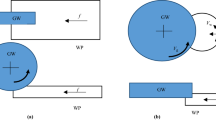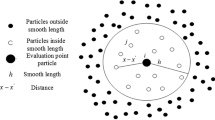Abstract
Subsurface damages (SSD) induced during grinding of brittle materials influence mechanical and physical properties of the machined specimen. Experimental evaluation of SSD is very expensive and time consuming due to need for performing various grinding testes in one hand and post-grinding processes such as angle polishing in another hand. Meanwhile, theoretical investigation lacks accuracy due to the various simplifications involved with theoretical models. Hence, a numerical study was performed to analyze SSD in optical glass grinding using finite element method. The constitutive material behavior of glass was defined based on the Johnson-Holmquist model. Performing FEM simulations, the SSD depth was obtained for various combinations of process parameters. Based on the statistical analysis of variance, feed velocity was found to be the most significant parameter followed by depth of cut and cutting velocity. The numerical results were then compared with experimental observations using angle polishing technique and Scanning Electron Microscopy. This comparison reveals good performance of FEM in prediction of SSD depth. Finally, an empirical/ mathematical model was developed to express SSD depth as a function of process parameters. The regression model revealed that by increasing feed velocity and cutting depth, SSD depth increases, while by increasing cutting velocity, SSD depth decreases.
Similar content being viewed by others
Abbreviations
- ap :
-
depth of cut
- Vf :
-
feed velocity
- Vc :
-
cutting velocity
References
Yao, Z., Gu, W., and Li, K., “Relationship between Surface Roughness and Subsurface Crack Depth during Grinding of Optical Glass BK7,” Journal of Materials Processing Technology, Vol. 212, No. 4, pp. 969–976, 2012.
Zhao, Q., Chen, J., Huang, H., and Fang, X., “Grinding Damage of BK7 using Copper-Resin Bond Coarse-Grained Diamond Wheel,” Int. J. Precis. Eng. Manuf., Vol. 12, No. 1, pp. 5–13, 2011.
Agarwal, S. and Venkateswara, P., “Experimental Investigation of Surface/Subsurface Damage Formation and Material Removal Mechanisms in SiC Grinding,” International Journal of Machine Tools and Manufacture, Vol. 48, No. 6, pp. 698–710, 2008.
Gu, W., Yao, Z., and Li, H., “Investigation of Grinding Modes in Horizontal Surface Grinding of Optical Glass BK7,” Journal of Materials Processing Technology, Vol. 211, No. 10, pp. 1629–1636, 2011.
Marshall, D. B., Evans, A. G., and Khmi-Yakub, B. T, “The Nature of Machining Damage in Brittle Materials,” Proceedings of the Royal Society of London A: Mathematical, Physical and Engineering Sciences, Vol. 385, No. 1789, pp. 461–475, 1983.
Pashmforoush, F. and Rahimi, A., “Numerical-Experimental Study on the Mechanisms of Material Removal during Magnetic Abrasive Finishing of Brittle Materials Using Extended Finite Element Method,” Proceedings of the Institution of Mechanical Engineers Part C: Journal of Mechanical Engineering Science, Vol. 230, No. 9, pp. 1498–1510, 2016.
Feng, J., Chen, P., and Ni, J., “Prediction of Surface Generation in Microgrinding of Ceramic Materials by Coupled Trajectory and Finite Element Analysis,” Finite Elements in Analysis and Design, Vol. 57, pp. 67–80, 2012.
Malkin, S. and Hwang, T. W., “Grinding Mechanisms for Ceramics,” CIRP Annals-Manufacturing Technology, Vol. 45, No. 2, pp. 569–580, 1996.
Bifano, T. G., Dow, T. A., and Scattergood R. O., “Ductile Regime Grinding- A New Technology for Machining Brittle Materials,” Journal of Engineering for Industry, Vol. 113, No. 2, pp. 184–189, 1991.
Zhong, Z. W. and Venkatesh, V. C., “Recent Developments in Grinding of Advanced Materials,” International Journal of Advanced Manufacturing Technology, Vol. 41, No. 5, pp. 468–480, 2009.
Sivanandini, M., Dhami, S. S., and Pabla, B. S., “Material Removal by Chemical Mechanical Polishing-A Review,” International Journal of Advancements in Research & Technology, Vol. 1, No. 5, pp. 137–144, 2012.
Liu, W. J., Pei, Z. J., and Xin, X. J., “Finite Element Analysis for Grinding and Lapping of Wire-Sawn Silicon Wafers,” Journal of Materials Processing Technology, Vol. 129, No. 1, pp. 2–9, 2002.
Yu, T., Li, H., and Wang, W., “Experimental Investigation on Grinding Characteristics of Optical Glass BK7: With Special Emphasis on the Effects of Machining Parameters,” International Journal of Advanced Manufacturing Technology, Vol. 82, No. 5, pp. 1405–1419, 2016.
Lambropoulos, J. C., Li, Y., Funkenbusch, P., and Ruckman, J., “Non-Contact Estimate of Grinding-Induced Subsurface Damage,” Proc. of SPIE's International Symposium on Optical Science, Engineering, and Instrumentation, Vol. 11, pp. 41–50, 1999.
Li, S., Wang, Z., and Wu, Y., “Relationship between Subsurface Damage and Surface Roughness of Optical Materials in Grinding and Lapping Processes,” Journal of Materials Processing Technology, Vol. 205, No. 1, pp. 34–41, 2008.
Esmaeilzare, A., Rahimi, A., and Rezaei, S. M., “Investigation of Subsurface Damages and Surface Roughness in Grinding Process of Zerodur® Glass-Ceramic,” Applied Surface Science, Vol. 313, pp. 67–75, 2014.
Doman, D. A., Warkentin, A., and Bauer, R., “Finite Element Modeling Approaches in Grinding,” International Journal of Machine Tools and Manufacture, Vol. 49, No. 2, pp. 109–116, 2009.
Doman, D. A., “Rubbing and Plowing Phases in Single Grain Grinding,” Ph.D. Thesis, Dalhousie University, 2006.
Anderson, D., Warkentin, A., and R. Bauer, “Experimental Validation of Numerical Thermal Models for Shallow and Deep Dry Grinding,” Journal of Materials Processing Technology, Vol. 204, No. 1, pp. 269–278, 2008.
Ohbuchi, Y. and Obikawa, T., “Finite Element Modeling of Chip Formation in the Domain of Negative Rake Angle Cutting,” Journal of Engineering Materials and Technology, Vol. 125, No. 3, pp. 324–332, 2003.
Johnson, G. R. and Holmquist, T. J., “An Improved Computational Constitutive Model for Brittle Materials,” High-Pressure Science and Technology, Vol. 309, No. 1, pp. 981–984, 1994.
Brissot, M., Brient, A., Sangleboeuf, J. C., and Rouxel., T., “Grinding of Glass: Optimization of Process Parameters to Improve Surface Roughness,” IDMME-Virtual Concept, Bordeaux, France. Vol. 3, Research in Interactive Design, 2010.
Barahimi, V. and Farahnakian, M., “Experimental Investigation of the Surface Roughness in Grinding of BK7 Optical Glass in Brittle Mode,” Journal of Modern Processes in Manufacturing and Production, Vol. 5, No. 2, pp. 33–41, 2016.
Author information
Authors and Affiliations
Corresponding author
Rights and permissions
About this article
Cite this article
Pashmforoush, F., Esmaeilzare, A. Experimentally validated finite element analysis for evaluating subsurface damage depth in glass grinding using Johnson-Holmquist model. Int. J. Precis. Eng. Manuf. 18, 1841–1847 (2017). https://doi.org/10.1007/s12541-017-0213-2
Received:
Revised:
Accepted:
Published:
Issue Date:
DOI: https://doi.org/10.1007/s12541-017-0213-2




